Macau May 12, 2012
I’m sure Thomas Friedman did not have Macao (as the Portuguese would spell it) in mind when he wrote Hot, Flat and Crowded, but that was certainly an apt description of that Special Economic Region today. Once a sleepy backwater (probably since the Opium War catapulted Hong Kong ahead of it as an entrepot for the China trade, with the possible exception of World War II, when Macao was neutral, thus a magnet for refugees and a haven for spies), the handover in 1999 has given THE gambling spot in East Asia a sharp boost. The city of 300,000 or so in 1999 now houses over 550,000, with a floating population of 80,000 laborers, 300,000 visitors from the mainland on a weekend (it is THE gambling magnet for a population that loves to gamble), not to mention the ferry boats from Hong Kong that brought us and other throngs to the peninsula. It’s only an hour away, and you get a passport stamp! Plus, for me and Ruth Ann, there’s a seniors line that is at least fifteen minutes shorter through customs.
A former Portuguese possession, Macao’s separation from China was by “accident.” Portuguese sailors (and it’s hard to imagine, standing in Lisbon and looking out at the great unknown ocean) pushed the known (European) world boundaries around the Cape of Good Hope and into Asia, abetted by the Pope’s division of the colonial world between the Spanish and the Portuguese (which made Brazil a Portuguese colony as well). They landed in Macao in 1517 or so, but a half century later claimed they were “shipwrecked” and eventually got a foothold that became the base for European trade and missionary expansion. The great Jesuits passed through Macao in their efforts to penetrate China (we’re likely to see the observatory and the astronomical gifts that won Father Ricci a place in China, having honed his skills in Macao, which had the first Western-style university in Asia). The Portuguese fought off the Dutch in the 17th century, and provided the base for other European traders in the 18th.
The first US ship appeared off Macanese waters in 1786, the beginning of a long history of Sino-American trade. It was also in Macao that Caleb Cushing, an American diplomat, signed the treaty of Wanghsia in 1844, giving Americans the same rights that the British had won in the Opium War, the so-called unequal treaties that ushered in what the Chinese call “The century of humiliation.” It was, in fact, in Macao that Chinese commissioner Lin Teh-hsiu burned the opium stored in the colony, triggering the Opium War. The foreigners had, up till then, been permitted to trade only in Canton, living there temporarily during the trading season, then packing up and returning to Macao—until Hong Kong displaced it.
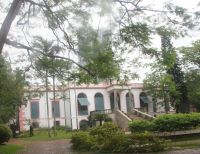
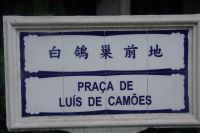 Macao definitely has a Mediterranean feel, and for those who have followed my blogs, you know that because of my fascination for this pastel-colored community, I had to go to Portugal (well, I wanted to). I found that the pastels were Portuguese: the governor’s office is a coral pink, as is the King’s Palace in Lisbon, for example. The egg tart, one of the prime desserts in Portugal, has its counterpart in Macao (and there are some other foods that you find only in Portuguese possessions; many years ago when I stayed in Macao with students, we dined at the former officers’ club—also pink—which had a rather long list of port wines, certainly one of Portugal’s main products). And I got into Leal Senado, the library cum legislative headquarters, with its blue and white tile garden that could have been in Lisbon or Porto or….
Macao definitely has a Mediterranean feel, and for those who have followed my blogs, you know that because of my fascination for this pastel-colored community, I had to go to Portugal (well, I wanted to). I found that the pastels were Portuguese: the governor’s office is a coral pink, as is the King’s Palace in Lisbon, for example. The egg tart, one of the prime desserts in Portugal, has its counterpart in Macao (and there are some other foods that you find only in Portuguese possessions; many years ago when I stayed in Macao with students, we dined at the former officers’ club—also pink—which had a rather long list of port wines, certainly one of Portugal’s main products). And I got into Leal Senado, the library cum legislative headquarters, with its blue and white tile garden that could have been in Lisbon or Porto or….
Although there were few Portuguese in Macao, the Portuguese left other legacies. Portuguese is one of three official languages in what is now a Special Administrative Region. As Portugal honors its former colonies in Lisbon (when you’re there, visit the Museum of the Far East), Macao has not turned its back on the Portuguese background. It plays up the tourist 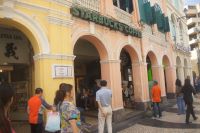
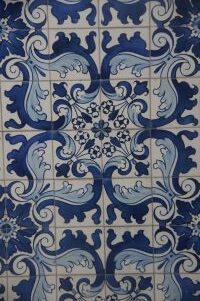 dimension of the historic center, focused on a kilometer- long area from Leal Senado (the main public square with pastel-colored colonial buildings, one of which hosts one of the most interesting McDonalds, another doing the same for Starbucks) to the shell of a 17th century church/fort which was devastated in a fire. The façade is left, and is one of the most famous non-buildings, I would think, in the world.
dimension of the historic center, focused on a kilometer- long area from Leal Senado (the main public square with pastel-colored colonial buildings, one of which hosts one of the most interesting McDonalds, another doing the same for Starbucks) to the shell of a 17th century church/fort which was devastated in a fire. The façade is left, and is one of the most famous non-buildings, I would think, in the world.
The former Church of the Mother of God, it has become known as St. Paul’s ruins, including the remains of that Jesuit college that pioneered higher education in Asia, and trained generations of missionaries. In looking at it, I realized why the Jesuits got banned in 1762. On the top of the building are Chinese dragons. The Jesuits got caught in several controversies—including the so-called “Rites,” where they accepted into Catholic theology the notion that local practices were not antithetical to Christianity. Heresy in 1762. In any case, there is a building heritage of churches . I think our guide noted there were 27 churches and 28 casinos, the latter with far more 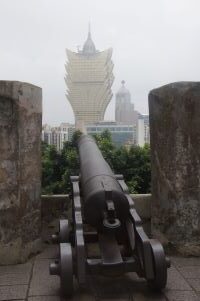 devotees. (There’s a lesson in those numbers!). One nice addition to the Jesuit-built fort (which withstood a Dutch invasion on St. John the Baptist day, making him the patron saint of the city) is the development of a museum that combines history and business and culture.
devotees. (There’s a lesson in those numbers!). One nice addition to the Jesuit-built fort (which withstood a Dutch invasion on St. John the Baptist day, making him the patron saint of the city) is the development of a museum that combines history and business and culture.
One place I got us taken to is the Protestant cemetery, which I learned was maintained by the East India Company, one of those links that tie China and India together historically. The Honourable Company (see John Keay’s book) brought opium from India to China in exchange for teas, silks,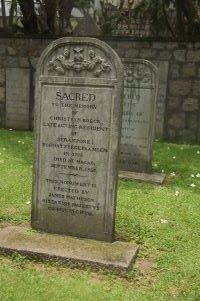 pottery, etc. The cost was sometimes high, as the cemetery gravestones makes clear; death aboard ships in war and peace, in childbirth, from dysentery and plague, storming the heights of the Boca Tigris forts at Canton, etc.
pottery, etc. The cost was sometimes high, as the cemetery gravestones makes clear; death aboard ships in war and peace, in childbirth, from dysentery and plague, storming the heights of the Boca Tigris forts at Canton, etc.
The main business of Macao, however, is tourism, and as I’ve said, it’s THE gambling spot in a region that loves to gamble. Until 2002, Macao gambling was the monopoly of Stanley Ho, whose four wives occasionally make the news in their squabbling to divide his wealth (he’s in his 80s). The “opening” of the gambling trade (that’s 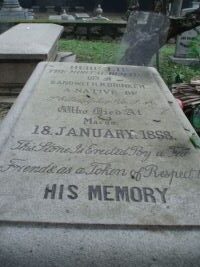 supposed to be a pun on the opening of the China trade and the open door policy that it helps to be a Ph.D. to recognize) brought a number of US companies into the picture—Wynn and the Sands, for example–and today the revenues from the casinos in Macao are much higher than those in Las Vegas. In any case, Mr. Ho built a “Grand Lisboa,” a bigger and better version of the “Lisboa” to welcome his new rivals, and we spent about 45 minutes ogling the décor—chandeliers and 4 foot long carved ivory tusks, gold boats, etc. 40% of the revenue is taxed, making Macao one of the most prosperous provinces of China. The casino was mobbed, but not hot; the streets were hot, flat, and definitely crowded.
supposed to be a pun on the opening of the China trade and the open door policy that it helps to be a Ph.D. to recognize) brought a number of US companies into the picture—Wynn and the Sands, for example–and today the revenues from the casinos in Macao are much higher than those in Las Vegas. In any case, Mr. Ho built a “Grand Lisboa,” a bigger and better version of the “Lisboa” to welcome his new rivals, and we spent about 45 minutes ogling the décor—chandeliers and 4 foot long carved ivory tusks, gold boats, etc. 40% of the revenue is taxed, making Macao one of the most prosperous provinces of China. The casino was mobbed, but not hot; the streets were hot, flat, and definitely crowded.
I think it’s been Hot, Flat, and Crowded for a long time; I’m convinced that humidity can be more than 100%, but for me, it was also fun!